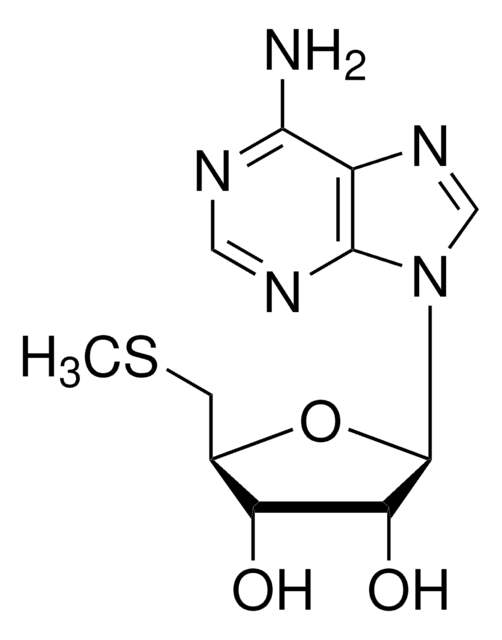Key Documents
D5628
Digitonin
~50% (TLC)
Synonim(y):
Digitin
About This Item
Polecane produkty
pochodzenie biologiczne
plant seeds (Digitalis purpurea)
Poziom jakości
opis
non-ionic
Próba
50% (TLC)
Postać
powder
masa cząsteczkowa
micellar avg mol wt 70,000
stężenie
~50% (TLC)
liczba agregacji
60
CMC
<0.5 mM (20-25°C)
mp
230-240 °C (dec.) (lit.)
rozpuszczalność
ethanol: 10 mg/mL, clear, colorless to faintly yellow
ciąg SMILES
C[C@@]12[C@]([C@@H]3C)([H])[C@](O[C@]34CC[C@@H](C)CO4)([H])[C@@H](O)[C@@]1([H])[C@@](CC[C@]5([H])[C@@]6(C[C@@H](O)[C@H](O[C@]([C@@H]([C@@H](O)[C@H]7O[C@@](O[C@H](CO)[C@@H](O)[C@@H]8O[C@@](OC[C@@H](O)[C@@H]9O)([H])[C@@H]9O)([H])[C@@H]8O[C@@](O[C@H](CO)[C@H
InChI
1S/C56H92O29/c1-19-7-10-56(75-17-19)20(2)31-45(85-56)37(67)32-22-6-5-21-11-26(24(61)12-55(21,4)23(22)8-9-54(31,32)3)76-50-42(72)39(69)44(30(16-60)80-50)81-53-48(47(36(66)29(15-59)79-53)83-49-40(70)33(63)25(62)18-74-49)84-52-43(73)46(35(65)28(14-58)78-52)82-51-41(71)38(68)34(64)27(13-57)77-51/h19-53,57-73H,5-18H2,1-4H3/t19-,20+,21+,22-,23+,24-,25-,26-,27-,28-,29-,30-,31+,32-,33+,34-,35+,36-,37+,38+,39-,40-,41-,42-,43-,44+,45-,46+,47+,48-,49+,50-,51+,52+,53+,54-,55+,56-/m1/s1
Klucz InChI
UVYVLBIGDKGWPX-KUAJCENISA-N
Szukasz podobnych produktów? Odwiedź Przewodnik dotyczący porównywania produktów
Opis ogólny
The detergent′s cellular permeabilization property extends to various cell types, enabling the study of intracellular components and processes by introducing antibodies, enzymes, or other molecules into cells. In immunocytochemistry experiments, Digitonin plays a crucial role by permeabilizing cells, allowing for the labeling and detection of intracellular proteins and structures, offering insights into cellular organization and protein localization. Furthermore, Digitonin facilitates RNA extraction and purification by lysing cells, a critical step for molecular biology applications such as gene expression analysis and RNA sequencing. The detergent′s utility is also evident in immunoprecipitation experiments, where it solubilizes membrane proteins, enabling the isolation of specific protein-antibody complexes for the study of protein interactions and signaling pathways.
Zastosowanie
- to incubate isolated mitochondria for removing the mitochondrial outer membrane for mitoplasts preparation
- in the permeabilization of HeLa cells for in vitro import assay
- as a component in HEPES-buffered saline (HBS) to permeate the cells and release the aequorins for fluorescence and bioluminescence imaging
Działania biochem./fizjol.
Cechy i korzyści
- Can extract membrane proteins like supercomplexes from the mitochondrial inner membrane
- Solubilizes 1-palmitoyl-2-oleoyl-sn-glycero-3-phosphocholine (POPC) large unilamellar vesicles (LUVs) gradually at high temperature
- Canorm micelles at a wide range of concentrations
Inne uwagi
produkt podobny
Hasło ostrzegawcze
Danger
Zwroty wskazujące rodzaj zagrożenia
Zwroty wskazujące środki ostrożności
Klasyfikacja zagrożeń
Acute Tox. 3 Oral - STOT RE 2
Kod klasy składowania
6.1C - Combustible acute toxic Cat.3 / toxic compounds or compounds which causing chronic effects
Klasa zagrożenia wodnego (WGK)
WGK 3
Temperatura zapłonu (°F)
Not applicable
Temperatura zapłonu (°C)
Not applicable
Środki ochrony indywidualnej
Eyeshields, Faceshields, Gloves, type P2 (EN 143) respirator cartridges
Certyfikaty analizy (CoA)
Poszukaj Certyfikaty analizy (CoA), wpisując numer partii/serii produktów. Numery serii i partii można znaleźć na etykiecie produktu po słowach „seria” lub „partia”.
Masz już ten produkt?
Dokumenty związane z niedawno zakupionymi produktami zostały zamieszczone w Bibliotece dokumentów.
Klienci oglądali również te produkty
Nasz zespół naukowców ma doświadczenie we wszystkich obszarach badań, w tym w naukach przyrodniczych, materiałoznawstwie, syntezie chemicznej, chromatografii, analityce i wielu innych dziedzinach.
Skontaktuj się z zespołem ds. pomocy technicznej











